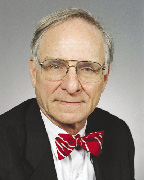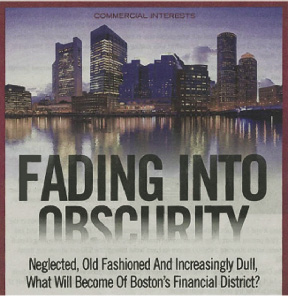Just imagine! On July 9, 2012 you receive your issue of the Banker & Tradesman and on the front page you read:
To those who for many years have earned livings through business relationships in the Financial District, and have occupied space within the Financial District, this article was not particularly pleasing.
The purpose of what I write herein is to present a contrary view based on my 40 years± of experience working within the Financial District.
What is the Financial District?
The Financial District in 1970 shifted 90º from the corner of State St. and started a strong march down Congress St. toward the Fort Point Channel. The Financial District now extends multiple blocks on either side of Congress St. with a reach up to Tremont St. and down to the Rose Kennedy Greenway. The Fort Point Channel is its eastern edge. The North End/Government Center is its northern edge and the Mass. Turnpike its southern edge.
Contrary to being neglected, old fashioned and dull, major redevelopments have or are taking place within its boundaries.
Let's Look at What's Happening
The "old fashioned and increasingly dull" moniker is being thrown off as Boston's Financial District is the heart of one of the 5 cities in the U.S. leading the way out of the Great Recession. Boston Properties would not have invested $100s of millions in cash in the Financial District's bleakest hour if they thought the Financial District was an irrelevant location.
In real estate, it is people who create value. The apartment sites that have been on the drawing board for years are now being developed and will add new employment and new people for Downtown:
The Kennsington, 385 units, delivery date 2013; 45 Stuart St., 404 units, delivery date 2014; Millennium Place, 185 units, delivery date 2013; 120 Kennsington St., 240 units, delivery date 2014; Parcel 24, units 295, delivery date 2014.
With a 3.2% apartment vacancy rate, and 4-4.5% high-rise cap rate, the apartment market leads the Financial District rebirth.
The five sites shown above, all scheduled for construction completion in 2013 and 2014, will bring 1,509 rented apartment units to the Financial District. The Filene's site with its 606' proposed tower is to add 500 units plus 230,000 s/f of retail and 250,000 s/f of offices. In size, this will be one of the largest buildings in the city totaling over 1.4 million s/f and will complement developments already created by Millennium. I doubt that Millennium thinks the CBD is dull.
Future Events
The city of Boston, with the Financial District, is one of the major targeted areas for foreign capital. CBRE is a firm with global reach. Boston, like London, is a 24 hour city. 40% of all trades in London so far this year are from new capital sources never seen before. It is places like Boston's Downtown that will attract new money.
What must be kept in mind is that Boston is a quiet town. A lot is going on behind the scenes that will benefit the city. Some very big moves have already been made. The 2008 purchase of the former telephone company building, carried through the downturn, is now ready for prime time.
Hotels will create vibrancy within the Financial District. Existing buildings of 1920s vintage have perfect hotel floor plates and adaptive re-use will be the result for buildings described as "ghostly monument(s)."
Boston is one of the top 3-5 lodging markets in the U.S. The Financial District is a prime location for boutique hotels.
Finally, both the Seaport and Back Bay have priced rents 20%± above the Downtown market. Basic economics will move tenants back into Downtown.
Conclusions
"The buzz in Boston" has been the referenced July 9, 2012 article. What the article misses is that from the top down to bottom up, the Financial District is the best place to be. This article is written as of the close of day on July 18, 2012.
On July 20, 2012 CBRE/New England moves its Back Bay office to a full floor at 33 Arch St., an example of a move back to Downtown.
What is clear is that the stars are all aligning on Downtown, be it apartments, office, hotels or retail. Basic economics with very low debt and record low capitalization rates are instrumental in maximizing of value, minimizing risk and improving the constraints that the Financial District will see a recovery of fundamental as we rise out of the economic storms and its headwinds of the past 5± years.
Webster Collins, MAI, CRE, FRICS is executive vice president/partner the valuation & advisory group of CBRE/New England, Boston.
Tags:
From the top down to bottom up, the Financial District is the best place to be in Boston
July 26, 2012 - Spotlights









